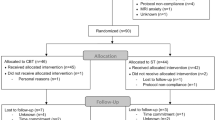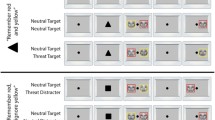Abstract
Background
Altered amygdala activation in response to the emotional matching faces (EMF) task, a task thought to reflect implicit emotion detection and reactivity, has been found in some patients with internalizing disorders; mixed findings from the EMF suggest individual differences (within and/or across diagnoses) that may be important to consider. Attention Bias Modification (ABM), a mechanistic attention-targeting intervention, has demonstrated efficacy in treatment of internalizing disorders. Individual differences in neural activation to a relatively attention-independent task, such as the EMF, could reveal novel neural substrates relevant in ABM’s transdiagnostic effects, such as the brain’s generalized threat reactivity capacity.
Methods
In a sample of clinically anxious patients randomized to ABM (n = 43) or sham training (n = 18), we measured fMRI activation patterns during the EMF and related them to measures of transdiagnostic internalizing symptoms (i.e., anxious arousal, general distress, anhedonic depression, and general depressive symptoms).
Results
Lower baseline right amygdala activation to negative (fearful/angry) faces, relative to shapes, predicted greater pre-to-post reduction in general depression symptoms in ABM-randomized patients. Greater increases in bilateral amygdalae activation from pre-to-post ABM were associated with greater reductions in general distress, anhedonic depression, and general depression symptoms.
Conclusions
ABM may lead to greater improvement in depressive symptoms in individuals exhibiting blunted baseline amygdalar responses to the EMF task, potentially by enhancing neural-level discrimination between negative and unambiguously neutral stimuli. Convergently, longitudinal increases in amygdala reactivity from pre-to-post-ABM may be associated with greater improvement in depression, possibly secondary to improved neural discrimination of threat and/or decreased neurophysiological threat avoidance in these specific patients.




Similar content being viewed by others
References
Amir, N., Beard, C., Burns, M., & Bomyea, J. (2009). Attention modification program in individuals with generalized anxiety disorder. Journal of Abnormal Psychology, 118(1), 28.
Beck, A. T., Steer, R. A., & Carbin, M. G. (1988). Psychometric properties of the Beck Depression Inventory: Twenty-five years of evaluation. Clinical Psychology Review, 8(1), 77–100.
Behar, E., Alcaine, O., Zuellig, A. R., & Borkovec, T. (2003). Screening for generalized anxiety disorder using the Penn State Worry Questionnaire: A receiver operating characteristic analysis. Journal of Behavior Therapy and Experimental Psychiatry, 34(1), 25–43.
Benjamini, Y., & Hochberg, Y. (1995). Controlling the false discovery rate: A practical and powerful approach to multiple testing. Journal of the Royal Statistical Society Series B (Methodological), 57, 289–300.
Bradley, B. P., Mogg, K., White, J., Groom, C., & De Bono, J. (1999). Attentional bias for emotional faces in generalized anxiety disorder. British Journal of Clinical Psychology, 38(3), 267–278.
Britton, J. C., Suway, J. G., Clementi, M. A., Fox, N. A., Pine, D. S., & Bar-Haim, Y. (2015). Neural changes with attention bias modification for anxiety: a randomized trial. Social Cognitive and Affective Neuroscience, 10(7), 913–920.
Bylsma, L. M., Morris, B. H., & Rottenberg, J. (2008). A meta-analysis of emotional reactivity in major depressive disorder. Clinical Psychology Review, 28(4), 676–691.
Bystritsky, A. (2006). Treatment-resistant anxiety disorders. Molecular Psychiatry, 11(9), 805.
Clark, L. A., & Watson, D. (1991). Tripartite model of anxiety and depression: Psychometric evidence and taxonomic implications. Journal of Abnormal Psychology, 100(3), 316.
Cooney, R. E., Atlas, L. Y., Joormann, J., Eugène, F., & Gotlib, I. H. (2006). Amygdala activation in the processing of neutral faces in social anxiety disorder: Is neutral really neutral? Psychiatry Research: Neuroimaging, 148(1), 55–59.
Ekman, P. (1976). Pictures of facial affect. Consulting Psychologists Press.
Etkin, A., & Wager, T. D. (2007). Functional neuroimaging of anxiety: A meta-analysis of emotional processing in PTSD, social anxiety disorder, and specific phobia. American Journal of Psychiatry, 164(10), 1476–1488.
Evans, K. C., Wright, C. I., Wedig, M. M., Gold, A. L., Pollack, M. H., & Rauch, S. L. (2008). A functional MRI study of amygdala responses to angry schematic faces in social anxiety disorder. Depression and Anxiety, 25(6), 496–505.
Fonzo, G. A., Ramsawh, H. J., Flagan, T. M., Sullivan, S. G., Letamendi, A., Simmons, A. N., et al. (2015). Common and disorder-specific neural responses to emotional faces in generalised anxiety, social anxiety and panic disorders. The British Journal of Psychiatry, 206(3), 206–215.
Frank, D., Dewitt, M., Hudgens-Haney, M., Schaeffer, D., Ball, B., Schwarz, N., et al. (2014). Emotion regulation: Quantitative meta-analysis of functional activation and deactivation. Neuroscience and Biobehavioral Reviews, 45, 202–211.
Fusar-Poli, P., Placentino, A., Carletti, F., Landi, P., Allen, P., Surguladze, S., et al. (2009). Functional atlas of emotional faces processing: A voxel-based meta-analysis of 105 functional magnetic resonance imaging studies. Journal of Psychiatry and Neuroscience, 34, 418–432.
Gentili, C., Cristea, I. A., Angstadt, M., Klumpp, H., Tozzi, L., Phan, K. L., & Pietrini, P. (2016). Beyond emotions: A meta-analysis of neural response within face processing system in social anxiety. Experimental Biology and Medicine, 241(3), 225–237.
Hägele, C., Friedel, E., Schlagenhauf, F., Sterzer, P., Beck, A., Bermpohl, F., et al. (2016). Affective responses across psychiatric disorders: A dimensional approach. Neuroscience Letters, 623, 71–78.
Hariri, A. R., Tessitore, A., Mattay, V. S., Fera, F., & Weinberger, D. R. (2002). The amygdala response to emotional stimuli: A comparison of faces and scenes. Neuroimage, 17(1), 317–323.
Hölzel, B. K., Hoge, E. A., Greve, D. N., Gard, T., Creswell, J. D., Brown, K. W., et al. (2013). Neural mechanisms of symptom improvements in generalized anxiety disorder following mindfulness training. NeuroImage: Clinical, 2, 448–458.
Honkalampi, K., Hintikka, J., Laukkanen, E., & Viinamäki, J. L. H. (2001). Alexithymia and depression: A prospective study of patients with major depressive disorder. Psychosomatics, 42(3), 229–234.
Jones, E. B., & Sharpe, L. (2017). Cognitive bias modification: A review of meta-analyses. Journal of Affective Disorders, 223, 175–183.
Kiefer, C. (2018). Neural correlates of emotional face processing in a community sample of adolescents with varying irritability and anxiety symptoms. San Diego: San Diego State University.
Linetzky, M., Pergamin-Hight, L., Pine, D. S., & Bar-Haim, Y. (2015). Quantitative evaluation of the clinical efficacy of attention bias modification treatment for anxiety disorders. Depression and Anxiety, 32(6), 383–391.
MacNamara, A., Klumpp, H., Kennedy, A. E., Langenecker, S. A., & Phan, K. L. (2017). Transdiagnostic neural correlates of affective face processing in anxiety and depression. Depression and Anxiety, 34(7), 621–631.
Masson, S. C. (2013). Minimum clinically important differences identified for commonly used depression rating scales. Journal of Clinical Epidemiology, 66(7), 805.
Mingtian, Z., Shuqiao, Y., Xiongzhao, Z., Jinyao, Y., Xueling, Z., Xiang, W., et al. (2012). Elevated amygdala activity to negative faces in young adults with early onset major depressive disorder. Psychiatry Research: Neuroimaging, 201(2), 107–112.
Mogg, K., & Bradley, B. P. (2016). Anxiety and attention to threat: Cognitive mechanisms and treatment with attention bias modification. Behaviour Research and Therapy, 87, 76–108.
Nyklíček, I., Vingerhoets, A., & Zeelenberg, M. (2007). Emotion regulation: Conceptual and clinical issues. New York: Springer.
Price, R. B., Cummings, L., Gilchrist, D., Graur, S., Banihashemi, L., Kuo, S. S., & Siegle, G. J. (2018). Towards personalized, brain-based behavioral intervention for transdiagnostic anxiety: Transient neural responses to negative images predict outcomes following a targeted computer-based intervention. Journal of Consulting and Clinical Psychology, 86(12), 1031.
Price, R. B., Rosen, D., Siegle, G. J., Ladouceur, C. D., Tang, K., Allen, K. B., et al. (2016a). From anxious youth to depressed adolescents: Prospective prediction of 2-year depression symptoms via attentional bias measures. Journal of Abnormal Psychology, 125(2), 267.
Price, R. B., Wallace, M., Kuckertz, J. M., Amir, N., Graur, S., Cummings, L., et al. (2016b). Pooled patient-level meta-analysis of children and adults completing a computer-based anxiety intervention targeting attentional bias. Clinical Psychology Review, 50, 37–49.
R Core Team. (2019). R: A language and environment for statistical computing. Austria: R Foundation for Statistical Computing.
Richards, D. (2011). Prevalence and clinical course of depression: A review. Clinical Psychology Review, 31(7), 1117–1125. https://doi.org/10.1016/j.cpr.2011.07.004.
Rottenberg, J., & Hindash, A. C. (2015). Emerging evidence for emotion context insensitivity in depression. Current Opinion in Psychology, 4, 1–5.
Sambuco, N., Bradley, M., Herring, D., Hillbrandt, K., & Lang, P. J. (2019). Transdiagnostic trauma severity in anxiety and mood disorders: Functional brain activity during emotional scene processing. Psychophysiology. https://doi.org/10.1111/psyp.13349.
Sartorius, N., Üstün, T. B., Lecrubier, Y., & Wittchen, H.-U. (1996). Depression comorbid with anxiety: Results from the WHO study on psychological disorders in primary health care. The British Journal of Psychiatry, 168(S30), 38–43.
Schulze, L., Schulze, A., Renneberg, B., Schmahl, C., & Niedtfeld, I. (2019). Neural correlates of affective disturbances: A comparative meta-analysis of negative affect processing in borderline personality disorder, major depressive disorder, and posttraumatic stress disorder. Biological Psychiatry: Cognitive Neuroscience and Neuroimaging, 4(3), 220–232.
Shin, L. M., & Liberzon, I. (2010). The neurocircuitry of fear, stress, and anxiety disorders. Neuropsychopharmacology, 35(1), 169.
Sobanski, T., & Wagner, G. (2017). Functional neuroanatomy in panic disorder: Status quo of the research. World Journal of Psychiatry, 7(1), 12.
Stein, M. B., Goldin, P. R., Sareen, J., Zorrilla, L. T. E., & Brown, G. G. (2002). Increased amygdala activation to angry and contemptuous faces in generalized social phobia. Archives of General Psychiatry, 59(11), 1027–1034.
Stuhrmann, A., Suslow, T., & Dannlowski, U. (2011). Facial emotion processing in major depression: A systematic review of neuroimaging findings. Biology of Mood and Anxiety Disorders, 1(1), 10.
Webb, T. L., Miles, E., & Sheeran, P. (2012). Dealing with feeling: A meta-analysis of the effectiveness of strategies derived from the process model of emotion regulation. Psychological Bulletin, 138(4), 775.
Woody, M. L., Yang, J. O., Cummings, L., Gilchrist, D., Graur, S., Siegle, G. J., & Price, R. B. (2019). Protracted amygdalar response predicts efficacy of a computer-based intervention targeting attentional patterns in transdiagnostic clinical anxiety. Translational Psychiatry, 9, 121.
World Health Organization. (2017). Depression and other common mental disorders: Global health estimates. Geneva: World Health Organization.
Acknowledgements
This project was supported by National Institute of Mental Health Grant (NIMH MH100259). This research was also supported by funding from the Ruth L. Kirschstein National Research Service Award Institutional Research Training Grants sponsored by the National Institutes of Health (NIH T32 MH018951: Brent) and by NIMH Grant K23 MH119225. The NIH had no role in the study design, collection, analysis or interpretation of the data, writing the manuscript, or the decision to submit the paper for publication.
Author information
Authors and Affiliations
Corresponding author
Ethics declarations
Conflict of Interest
Manivel Rengasamy, Mary Woody, Tessa Kovats, Greg Siegle and Rebecca B. Price declare that they have no conflict of interest.
Informent Consent
The study was approved by the Institutional Review Board of the University of Pittsburgh and informed consent was obtained from all participants. This study was carried out in accordance with the Declaration of Helsinki.
Animal Rights
No animals were carried out by the authors for this article.
Additional information
Publisher's Note
Springer Nature remains neutral with regard to jurisdictional claims in published maps and institutional affiliations.
Supplementary Information
Below is the link to the electronic supplementary material.
Rights and permissions
About this article
Cite this article
Rengasamy, M., Woody, M., Kovats, T. et al. What’s in a Face? Amygdalar Sensitivity to an Emotional Threatening Faces Task and Transdiagnostic Internalizing Disorder Symptoms in Participants Receiving Attention Bias Modification Training. Cogn Ther Res 45, 795–804 (2021). https://doi.org/10.1007/s10608-021-10205-9
Accepted:
Published:
Issue Date:
DOI: https://doi.org/10.1007/s10608-021-10205-9




